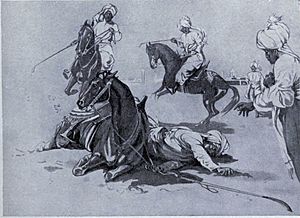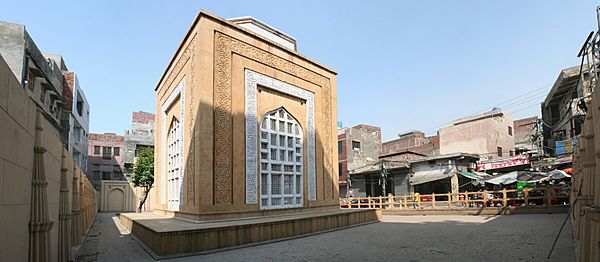Qutb ud-Din Aibak facts for kids
Quick facts for kids Quṭb ud-Dīn Aibak |
|
|---|---|
| Lakh baksha<br | |
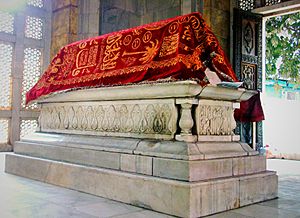
Grave of Qutb ud-Din Aybak, in Anarkali Bazaar in Lahore
|
|
| 1st Sultan of Delhi | |
| Reign | 25 June 1206 – 14 November 1210 |
| Coronation | 25 June 1206, Qasr-e-Humayun, Lahore |
| Predecessor | Muhammad of Ghor |
| Successor | Aram Shah |
| Born | 1150 Turkestan |
| Died | 14 November 1210 (aged 60) Lahore, Delhi Sultanate (present-day Lahore, Pakistan) |
| Burial | Anarkali Bazaar, Lahore |
Qutb ud-Din Aibak (Persian: قطبالدین ایبک) lived from 1150 to 1210. He was a brave Turkic general who worked for the Ghurid king Muhammad Ghori. Aibak was in charge of the Ghurid lands in northern India.
After Muhammad Ghori was killed in 1206, Aibak started his own kingdom. This kingdom became known as the Delhi Sultanate (1206–1526). He also began the Mamluk dynasty, which ruled the Sultanate until 1290.
Aibak was born in Turkestan. He was sold into slavery when he was a child. A kind judge, called a Qazi, bought him in Nishapur, Persia. There, Aibak learned important skills like archery and horse-riding. Later, he was sold to Muhammad Ghori in Ghazni. He quickly rose through the ranks, even becoming the officer in charge of the royal stables.
Aibak became very important after the Ghurids won the Second Battle of Tarain in 1192. Muhammad Ghori put him in charge of his Indian territories. Aibak then expanded Ghurid power across northern India. He conquered many places from different kingdoms like the Chahamanas and Gahadavalas.
When Muhammad Ghori died in 1206, Aibak became the ruler of India. He set up his capital in Lahore. He was officially recognized as the ruler of India in 1208-1209. Aibak is famous for starting the construction of the Qutb Minar in Delhi and the Adhai Din Ka Jhonpra in Ajmer.
Contents
Early Life and Rise to Power
Aibak was born around the year 1150. His name can be spelled in different ways, like "Qutb al-Din Aybeg." He came from Turkestan and belonged to a Turkic tribe called Aibak. The word "Aibak" means "moon lord" in Turkic languages.
When he was a child, Aibak was taken from his family. He was sold in the slave market of Nishapur. A kind judge, Qazi Fakhruddin Abdul Aziz Kufi, bought him. Aibak was treated well in the Qazi's home. He was educated alongside the Qazi's own sons. He learned to shoot arrows, ride horses, and recite the Quran.
Later, the Qazi sold Aibak to a merchant. This merchant then sold Aibak to the Ghurid Sultan Muhammad Ghori in Ghazni. Aibak was smart and kind. He quickly caught the Sultan's attention. Once, the Sultan gave gifts to his slaves. Aibak shared his gifts with the servants. This act impressed the Sultan, who gave Aibak a higher position.
Aibak became the Amir-i Akhur, which means the officer of the royal stables. He was in charge of the horses, their food, and their equipment. During a war, he was captured by enemy scouts. He was held in an iron cage. After the Ghurids won, Muhammad Ghori saw Aibak in the cage. He felt sorry for him and released him. From then on, the Sultan favored Aibak greatly.
Aibak's time in India can be seen in three parts:
- 1192-1206: He was an officer in charge of some of Sultan Muhammad Ghori's lands in northern India.
- 1206-1208: He became an informal ruler. He controlled Muhammad Ghori's former lands as a Malik (chief) and Sipah Salar (army commander) of Delhi and Lahore.
- 1208-1210: He became the official ruler of an independent kingdom in India.
A Ghurid General in India
Expanding Ghurid Power
Aibak was a general in the Ghurid army. This army was defeated by the Chahamana ruler Prithviraja III in the First Battle of Tarain. However, the Ghurids won the Second Battle of Tarain. Aibak played a key role in this victory. He was in charge of the Ghurid army's formation.
After the victory, Muhammad Ghori gave Aibak control of the former Chahamana territory. Aibak appointed Prithviraja's son, Govindaraja IV, as a ruler under Ghurid control. Later, Prithviraja's brother, Hariraja, tried to take back the Ranthambore Fort. Aibak quickly marched there and forced Hariraja to retreat.
In 1192, a rebel named Jatwan attacked the Hansi Fort. Aibak marched to Hansi and defeated Jatwan. Jatwan was killed in battle.
Conquests in Doab and Beyond
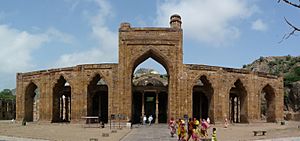
After defeating Jatwan, Aibak prepared to invade the Ganga-Yamuna Doab region. In 1192, he took control of Meerut and Baran (modern Bulandshahr). These places became bases for attacks against the Gahadavala kingdom. He also took control of Delhi in 1192. At first, he allowed the local Tomara ruler to stay as a vassal. But in 1193, he removed the Tomara ruler and took direct control of Delhi.
In 1193, Sultan Muhammad Ghori called Aibak to the Ghurid capital, Ghazni. Aibak stayed there for about six months. When he returned to India in 1194, he captured Koil (modern Aligarh).
Meanwhile, Hariraja had taken back some of the Chahamana territory. Aibak sent his army against Hariraja and defeated him. Aibak then placed Ajmer under a Muslim governor. He moved Govindaraja to Ranthambore.
War with the Gahadavalas
In 1194, Muhammad Ghori returned to India with a large army. At the Battle of Chandawar, they defeated the Gahadavala king Jayachandra, who was killed. After this victory, Muhammad Ghori continued east with Aibak leading the way. The city of Benares (Kashi) was captured. This victory helped the Ghurids set up military bases in many parts of the region.
Other Important Campaigns
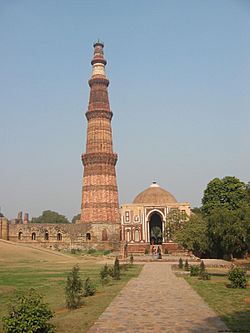
After the victory at Chandawar, Aibak focused on strengthening his control in Koil. Muhammad Ghori returned to Ghazni. He came back to India in 1195-96 and defeated the Bhati ruler of Bayana. He then marched towards Gwalior, where the local ruler accepted his authority.
Around Ajmer, the Mher tribes rebelled against Ghurid rule. They were supported by the Chaulukyas from Gujarat. Aibak marched against them but had to retreat to Ajmer. Reinforcements from Ghazni arrived, forcing the Mhers to retreat.
In 1197, Aibak defeated the Chaulukya army at Mount Abu. This avenged Muhammad Ghori's earlier defeat. Aibak's army then marched to the Chaulukya capital, Anhilwara. The king fled, and the city was plundered. However, Ghurid control of Gujarat did not last long. The Chaulukyas soon regained their capital.
Between 1197 and 1199, Aibak conquered Badaun and re-took Varanasi. He also captured Chantarwal and Kannauj. Later, he captured Siroh. Some historians believe he also raided Malwa in 1199–1200.
In 1202, Aibak attacked Kalinjar, an important fort in central India. The Chandela ruler, Paramardi, started talks with Aibak but died. The new Chandela leader continued fighting but was forced to negotiate when the Ghurids cut off their water supply. The Chandelas had to move, and Kalinjar, Mahoba, and Khajuraho came under Ghurid control.
Meanwhile, another Ghurid commander, Bakhtiyar Khalji, conquered parts of eastern Uttar Pradesh and Bihar. He destroyed Buddhist monasteries. Khalji later met Aibak and gave him war treasures, including elephants and jewels. Bakhtiyar acted on his own and was not under Aibak's direct command when he died in 1206.
In 1204, Muhammad Ghori faced a defeat against the Khwarazmians. Aibak helped him put down a rebellion by the Khokhar chiefs near Lahore. On March 15, 1206, Muhammad Ghori was killed.
Becoming the Sultan of Delhi
At the time of Sultan Muhammad Ghori's death in 1206, the Ghurids controlled many areas in India. However, their control was not strong everywhere.
Eastern India
Parts of Bihar and Bengal were conquered by the Khalji clan, led by Bakhtiyar Khalji. Bakhtiyar was killed by his subordinate, Ali Mardan Khalji, in 1206. Another subordinate, Muhammad Shiran Khalji, took over. Ali Mardan escaped to Delhi and convinced Aibak to get involved. Aibak sent his governor, Qaimaz Rumi, to Bengal. Rumi defeated Muhammad Shiran. Later, Aibak made Ali Mardan the governor of his territories in eastern India.
Recognized as Ruler
Aibak was based in Delhi when the Sultan died. The people of Lahore asked him to become their ruler. He moved his government to Lahore and informally took the throne on June 25, 1206. But he was not officially recognized as a sovereign ruler until 1208–1209.
In Ghazni, the Sultan's slaves and nobles fought for control. Muhammad Ghori's nephew, Ghiyath al-Din Mahmud, became the new Sultan. Aibak and other slave-generals sent messages to Mahmud. They asked for official permission to rule their territories.
Another slave-general, Taj al-Din Yildiz, wanted to control the Ghurid lands in India. After Sultan Mahmud recognized Yildiz as the ruler of Ghazni, Yildiz marched to Punjab. Aibak fought him, forcing Yildiz to retreat. Aibak then took control of Ghazni.
In 1208–1209, Sultan Mahmud officially recognized Aibak as the ruler of Hindustan. He also gave Aibak a ceremonial parasol, a symbol of royal power. Some historians say Mahmud called Aibak a "Sultan." However, no coins from Aibak have been found that call him a "Sultan."
Aibak became too comfortable in Ghazni. The people there invited Yildiz to remove him. Aibak had to escape to India. He then moved his capital to Lahore to protect his lands from Yildiz.
Death and Lasting Impact
After becoming the recognized ruler of India, Aibak focused on strengthening his control over his existing territories. He did not try to conquer many new lands. In 1210, while playing chovgan (a game like polo) in Lahore, he fell from his horse. The pommel of the saddle pierced his ribs, and he died instantly.
Historians describe Aibak as a loyal, generous, brave, and fair leader. His generosity earned him the nickname lakh-bakhsh, meaning "giver of hundreds of thousands." His soldiers were known for being disciplined. They would not take anything from peasants by force. Even centuries later, people used the phrase "Aibak of the time" to describe very generous people.
Aibak's conquests led to many people being taken as slaves. For example, his campaign in Gujarat resulted in 20,000 people being enslaved. His Kalinjar campaign led to 50,000 people being enslaved. While these numbers might be exaggerated, a large number of people were indeed captured.
Aibak died suddenly and had not named a successor. After his death, the Turkic officers in Lahore chose Aram Shah to rule. We don't know much about Aram Shah before he became ruler. Some people thought he was Aibak's son, but this is unlikely.
Aram Shah ruled for only about eight months. During this time, many governors started to act independently. Some Turkic officers then invited Aibak's former slave, Iltutmish, to take over. Aibak had bought Iltutmish after the conquest of Anhilwara in 1197. Aibak saw Iltutmish as a future ruler. He even called Iltutmish his son.
The nobles appointed Iltutmish as Aram Shah's successor. Iltutmish also married Aibak's daughter. Aram Shah challenged Iltutmish, but Iltutmish defeated and killed him. Iltutmish then brought the rebellious governors back under control. He turned the loosely held Ghurid territories into the powerful Delhi Sultanate.
Iltutmish was followed by his family members, and then by his slave Ghiyas ud din Balban. This line of kings is often called the Mamluk or Slave dynasty. However, this name is not completely accurate. Only Aibak, Iltutmish, and Balban were slaves. They were likely freed before they became rulers. The other rulers in this line were not slaves.
Today, Aibak's tomb is in Anarkali Bazaar, Lahore. The tomb was rebuilt in the 1970s to look like buildings from the Sultanate era. Before that, his grave was simple and surrounded by houses.
Personal Life
Historians mention that Aibak had three daughters. His first daughter married Nasir ad-Din Qabacha, the Ghurid governor of Multan. After she died, his second daughter also married Qabacha. His third daughter married Aibak's slave Iltutmish. Iltutmish later became the Sultan of Delhi after Aram Shah.
Cultural Contributions
Aibak started the building of the famous Qutb Minar in Delhi. He also supported writers and scholars. A writer named Fakhri Mudabbir dedicated his book of genealogies to Aibak. Another important historical work, Tajul-Ma'asir, likely began during Aibak's rule.
See also
 In Spanish: Qutb-ud-din Aibak para niños
In Spanish: Qutb-ud-din Aibak para niños


